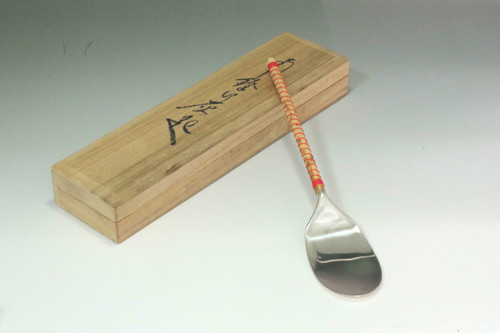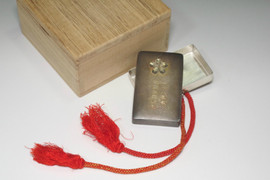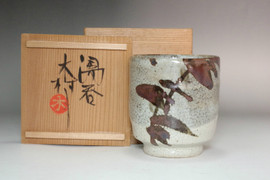Japanese Silver Spoon by Kimura Seigoro #5341
- SKU:
- 5341
- Shipping:
- Free Shipping
length: approx. 21.4cm (8.43in)
width: approx. 4.2cm (1.65in)
weight: approx. 34g (w/ box 110g)
This silver spoon is the work of Kimura Seigoro, one of Japan’s foremost silversmiths of the 20th century. Measuring approximately 21.4 cm in length and weighing about 34 grams, it is a superb piece that balances both functionality and aesthetic refinement. The spoon bowl features a soft teardrop shape with a smooth, lustrous silver finish that enhances its elegance. On the reverse, it is clearly marked with “銀” (silver), “90” indicating silver content, and the artist’s signature “Seigoro,” affirming both its material and maker. The piece comes with its original tomobako (signed wooden box), further elevating its value and presentation. It is preserved in excellent condition, with no noticeable damage, and stands as a valuable example of modern Japanese metalwork. This spoon would appeal strongly to collectors interested in Japanese silverware, lacquerware, or traditional crafts.
Kimura Seigoro was born in 1949 in Sanjo City, Niigata Prefecture.
In 1973, he began studying under the first-generation Kimura Seigoro, learning the techniques of metalworking.
In 1974, he received the Excellence Award from the Small and Medium Enterprise Agency.
In 1986, he was awarded the City Exhibition Prize.
In 1992, he succeeded the name and became the second-generation Kimura Seigoro.
His work mainly focuses on tea utensils such as hibashi (metal chopsticks for the hearth), haihishaku (ash scoops), mizusashi (water jars), and kiseru (smoking pipes), and is characterized by precise metalwork using namban-gin (pure silver). He also uses the artist name “Seiun,” and his works may bear the signature “Seigoro” or “Seiun.”
Kimura Seigoro’s creations are known for their simple forms and understated decoration, often incorporating sophisticated techniques such as inlay. His works are highly valued for their dual nature as practical tea utensils and fine art objects, and are held in high regard by collectors and tea ceremony practitioners alike.













